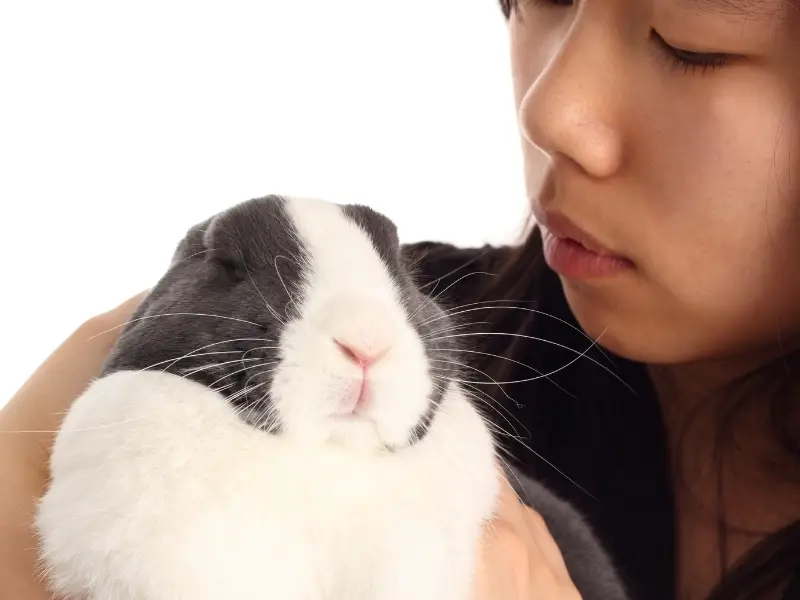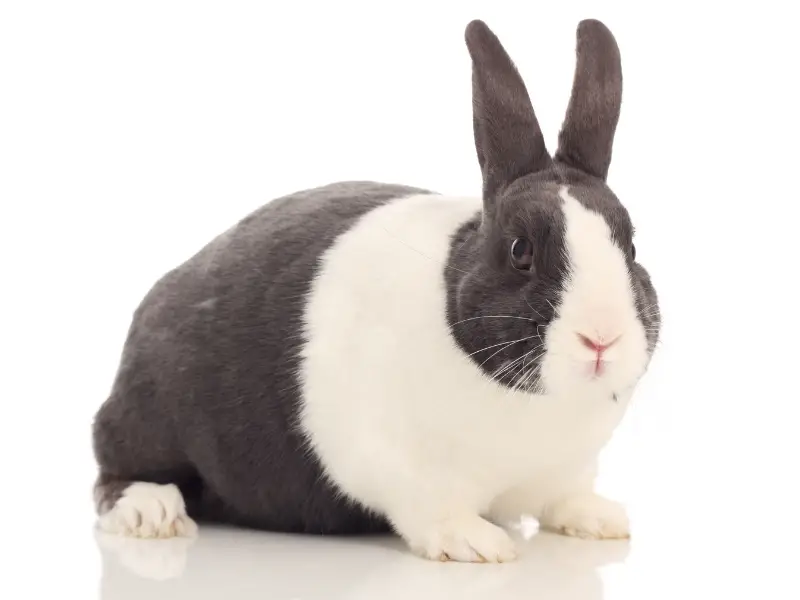One of the oldest breeds of rabbit, the Dutch rabbit is easily recognizable for its color markings. Small to medium in size, Dutch rabbits are playful, curious, and easy-going furballs that prefer to have company and are best kept in pairs.
So, are Dutch bunnies good pets? Dutch rabbits make fantastic pets for people of all ages and families with children. Gentle, kind, and friendly, these small bunnies make amazing first-time pets for older children. Though they get along nicely with younger kids, you should never leave your child to play unsupervised with a rabbit.
If you are looking for a friendly, calm, and easy-to-train pet bunny, the Dutch rabbit breed is a superb choice! Continue reading to learn more about the Dutch rabbit’s appearance, temperament, care, and more.
What Is a Dutch Rabbit?
Also known as Hollander or Brabander, the Dutch rabbit is one of the top 10 most popular breeds worldwide. Although the Dutch rabbit is a small breed, they aren’t dwarf rabbits.
Dutch Rabbit History and Origin
Although the Dutch rabbit’s name suggests that the breed originated in the Netherlands, it was actually developed in England.
During the 1830s rabbits were exported every week from Ostend in Belgium to England for the meat market. Among these rabbits was the breed called the Petit Brabancon, named after the place of its origin, Brabant in Flanders.
The rabbit breeders in England noticed that many Petit Brabancon rabbits had distinctive Dutch markings. They started breeding these rabbits separately, thus creating the Dutch rabbit breed.
Dutch rabbits quickly became popular and have since then been exported to all parts of the world. This breed is recognized by the American Rabbit Breeders Association and is a popular pet and show rabbit.
Dutch Rabbit Characteristics

According to the American Rabbit Breeders Association standard, the Dutch rabbit should be a small to medium-sized rabbit.
They should have a well-rounded body, rounded head, and short, broad, and well-furred ears. Their hind legs should be longer than the front legs and they have a short and glossy flyback coat.
Size, Weight, Shape
As mentioned previously, the Dutch rabbit is a small to medium-sized breed with a compact body type. Show-worthy Dutch rabbits weigh from 4 to 5.5 pounds.
Colors
The Dutch rabbit has a short and glossy flyback coat that is easy to maintain and goes through a seasonal molt. During this time, you will need to brush your bunny more often than usual to minimize the shedding.
Dutch rabbits are best known for their characteristic coat pattern that features two colors. Seven coat colors combined with white markings are recognized for show purposes, but new color varieties are under development.
For show purposes there are black, blue, chinchilla, chocolate, gray, steel, and tortoise varieties. Most Dutch rabbits will have dark brown eyes, except the blue, chinchilla, and chocolate rabbits who will have blue-grey or brown eyes.
The Dutch rabbit’s most striking trait is the marking pattern that remains the same in all Dutch rabbits regardless of their coat color.
All Dutch rabbits have a blaze which is an even wedge of white that runs up the rabbit’s face. It’s shaped by cheeks which are rounded circles of color on either side of the face.
The neck marking is a white wedge on the back of the head. All Dutch rabbits have a darkly colored saddle that starts behind their shoulders, and white legs.
Lifespan
The Dutch rabbits can live on average from five to eight years. Although they aren’t prone to any specific diseases, they can still suffer from common rabbit diseases (source). So take your bunny to regular veterinary checkups and care for it properly.
Temperament
Dutch rabbits are curious and friendly animals that like to spend time with people and enjoy their company. Thanks to their calm and easy-going nature, these small bunnies get along well with children and may make ideal playmates for your youngsters.
The Dutch is an active and curious rabbit that likes to explore and will happily hop around your home, investigating every nook and cranny.
When left inside their enclosures for too long, Dutch rabbits can become bored and depressed. Especially if they don’t live with another rabbit that can keep them company.
To keep your bunny in a good mood and ensure that they are living life to the fullest, interact with them every day and let them outside the enclosure. Letting your Dutch rabbit explore your home, play, and hop around will help them fulfill their social needs.
Dutch rabbits make wonderful first-time pets due to their gentle and calm demeanor. And because they are such social creatures they are a fantastic choice for singles, couples, families, or seniors, as long as they are able to care for the rabbit properly.
Like all other rabbits, the Dutch bunny can learn how to use a litter box. While possible, litter training a rabbit often takes more time and requires more patience than litter training a cat.
But in some time, with a bit of patience and tasty treats, your Dutch bunny will learn how to use a litter box and won’t pee and poo all over your home.
Dutch Rabbit Care
Like most other rabbits, the Dutch rabbit will live a long and happy life when cared for properly.
These small bunnies can live both indoors and outdoors. If you decide to keep your Dutch rabbit outside, pay attention to weather conditions and avoid keeping your pet in extreme temperatures.
When it comes to caring for your Dutch rabbit, pay attention to:
Enclosure
Despite their small size, Dutch rabbits need a spacious cage to live comfortably. The cage should be at least two feet wide by two feet long, but bigger is always better.
While wire cages are the best for rabbits, steer clear from those that have wire bottoms which can cause sore hocks. Instead, choose a material that won’t injure your rabbit’s feet and line it with bunny-safe bedding to make it even more comfortable.
Shredded paper or cardboard, hay, or wood shavings are good options and will help your bunny to feel good inside their cage. Spot clean the bedding every day and remove it completely once a week to maintain hygiene inside the cage.
Since Dutch rabbits are curious by nature and like to explore, let your bunny out of the cage every day. This will help your pet to stay exercised and also socialize them from a young age.
Diet
Like all other rabbits, the Dutch rabbit should be fed a diet of 70% hay. The remaining 30% should contain equal parts high-quality pellets, fruits, and vegetables.
Eating a hay-based diet is beneficial for your rabbit’s digestive system and dental health. Chewing on hay will naturally file your rabbit’s teeth and prevent them from becoming overgrown and start growing into their jaws and face.
When feeding your Dutch rabbit, make sure that they have access to fresh water at all times.
Coat
The Dutch rabbit has a short and glossy coat that is relatively easy to maintain. Like most other rabbit breeds, the Dutch bunny will go through a seasonal molt.
To keep your rabbit’s coat in good condition and to prevent hairballs, you’ll need to brush them once a week (source). During the molting season, brush your Dutch rabbit more often to keep the shedding to a minimum and to prevent your bunny from ingesting a ton of hair.
Never attempt to bathe a rabbit! The whole experience can be extremely stressful for your bunny and lead to a heart attack. Instead of a full-body wash spot clean your bunny’s coat using a damp cloth.
Dutch Rabbit Price
Expect to pay between $30 and $90 for a Dutch rabbit. Since Dutch rabbits are one of the most popular rabbit breeds you can easily find pet quality bunnies at pet stores as well as breeders.
Keep in mind that the Dutch rabbit’s price depends on several factors including the breeder, location, coat color and markings, and pedigree.
If you are looking for a show-quality Dutch rabbit the price will be higher and will largely depend on the quality of the coat and markings.
Conclusion
Easily recognizable thanks to its interesting coat markings, the Dutch rabbit is one of the most popular rabbit breeds. Small to medium in size, this cute bunny is fairly easy to maintain, and its coat doesn’t need a lot of grooming.
The great thing about Dutch rabbits is that they make wonderful first-time pets to people of all ages and families with children. Gentle, easy-going, cute, and friendly the Dutch rabbit gets along with everyone and will enjoy playing with your kids or exploring your home.
Related Articles:

